air condition TOYOTA YARIS HATCHBACK 2015 Owners Manual
[x] Cancel search | Manufacturer: TOYOTA, Model Year: 2015, Model line: YARIS HATCHBACK, Model: TOYOTA YARIS HATCHBACK 2015Pages: 540, PDF Size: 34.12 MB
Page 4 of 540

TABLE OF CONTENTS4
YARIS_F_WE_52G04E
6-1. Using the air conditioning
system and defogger
Manual air conditioning
system .............................306
Automatic air conditioning
system .............................313
Power heater .....................321
Seat heaters ......................323
6-2. Using the interior lights
Interior lights list .................325
• Interior light ....................325
• Personal lights ...............326
6-3. Using the storage features
List of storage features ......327
• Glove box ......................328
• Cup holders ...................329
• Bottle holders ................330
• Auxiliary box ..................331
Luggage compartment
features............................332
6-4. Using the other interior
features
Other interior features ........335
• Sun visors ......................335
• Vanity mirrors ................335
• Portable ashtray ............336
• Cigarette lighter .............337
• Power outlet ..................338
• Armrest ..........................339
• Panoramic roof shade ...339
• Assist grips ....................340
7-1. Maintenance and care
Cleaning and protecting
the vehicle exterior .......... 342
Cleaning and protecting
the vehicle interior ........... 345
7-2. Maintenance
Maintenance
requirements ................... 348
7-3. Do-it-yourself maintenance
Do-it-yourself service
precautions ..................... 351
Hood.................................. 354
Positioning a floor jack ...... 356
Engine compartment ......... 358
Tires .................................. 373
Tire inflation pressure........ 387
Wheels .............................. 389
Air conditioning filter .......... 392
Wireless remote control/
electronic key battery ...... 394
Checking and replacing
fuses ............................... 397
Light bulbs ......................... 403
6Interior features7Maintenance and care
Page 13 of 540
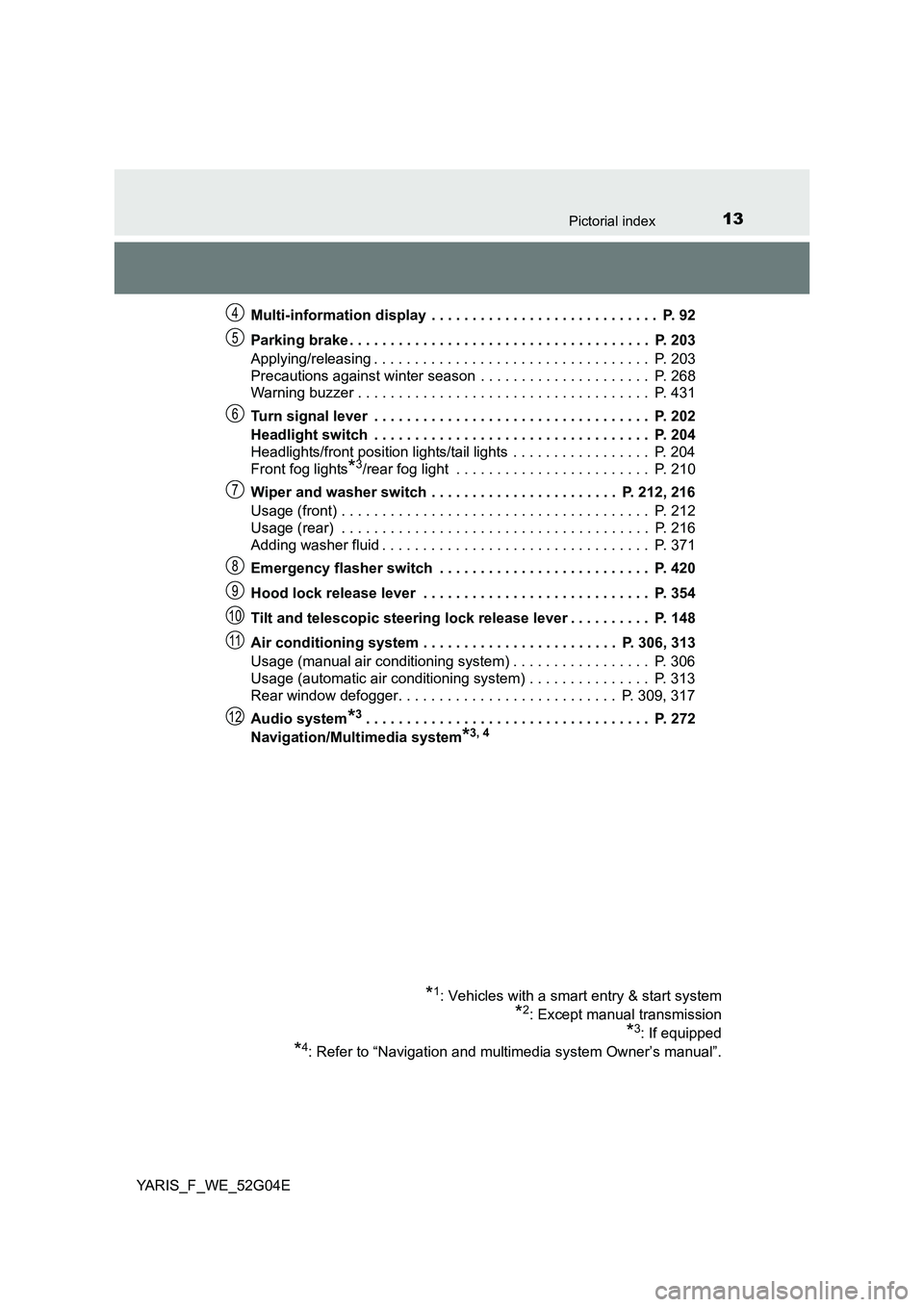
13Pictorial index
YARIS_F_WE_52G04E
Multi-information display . . . . . . . . . . . . . . . . . . . . . . . . . . . . P. 92
Parking brake . . . . . . . . . . . . . . . . . . . . . . . . . . . . . . . . . . . . . P. 203
Applying/releasing . . . . . . . . . . . . . . . . . . . . . . . . . . . . . . . . . . P. 203
Precautions against winter season . . . . . . . . . . . . . . . . . . . . . P. 268
Warning buzzer . . . . . . . . . . . . . . . . . . . . . . . . . . . . . . . . . . . . P. 431
Turn signal lever . . . . . . . . . . . . . . . . . . . . . . . . . . . . . . . . . . P. 202
Headlight switch . . . . . . . . . . . . . . . . . . . . . . . . . . . . . . . . . . P. 204
Headlights/front position lights/tail lights . . . . . . . . . . . . . . . . . P. 204
Front fog lights*3/rear fog light . . . . . . . . . . . . . . . . . . . . . . . . P. 210
Wiper and washer switch . . . . . . . . . . . . . . . . . . . . . . . P. 212, 216
Usage (front) . . . . . . . . . . . . . . . . . . . . . . . . . . . . . . . . . . . . . . P. 212
Usage (rear) . . . . . . . . . . . . . . . . . . . . . . . . . . . . . . . . . . . . . . P. 216
Adding washer fluid . . . . . . . . . . . . . . . . . . . . . . . . . . . . . . . . . P. 371
Emergency flasher switch . . . . . . . . . . . . . . . . . . . . . . . . . . P. 420
Hood lock release lever . . . . . . . . . . . . . . . . . . . . . . . . . . . . P. 354
Tilt and telescopic steering lock release lever . . . . . . . . . . P. 148
Air conditioning system . . . . . . . . . . . . . . . . . . . . . . . . P. 306, 313
Usage (manual air conditioning system) . . . . . . . . . . . . . . . . . P. 306
Usage (automatic air conditioning system) . . . . . . . . . . . . . . . P. 313
Rear window defogger. . . . . . . . . . . . . . . . . . . . . . . . . . . P. 309, 317
Audio system*3. . . . . . . . . . . . . . . . . . . . . . . . . . . . . . . . . . . P. 272
Navigation/Multimedia system*3, 4
*1: Vehicles with a smart entry & start system
*2: Except manual transmission
*3: If equipped
*4: Refer to “Navigation and multimedia system Owner’s manual”.
4
5
6
7
8
9
10
11
12
Page 20 of 540
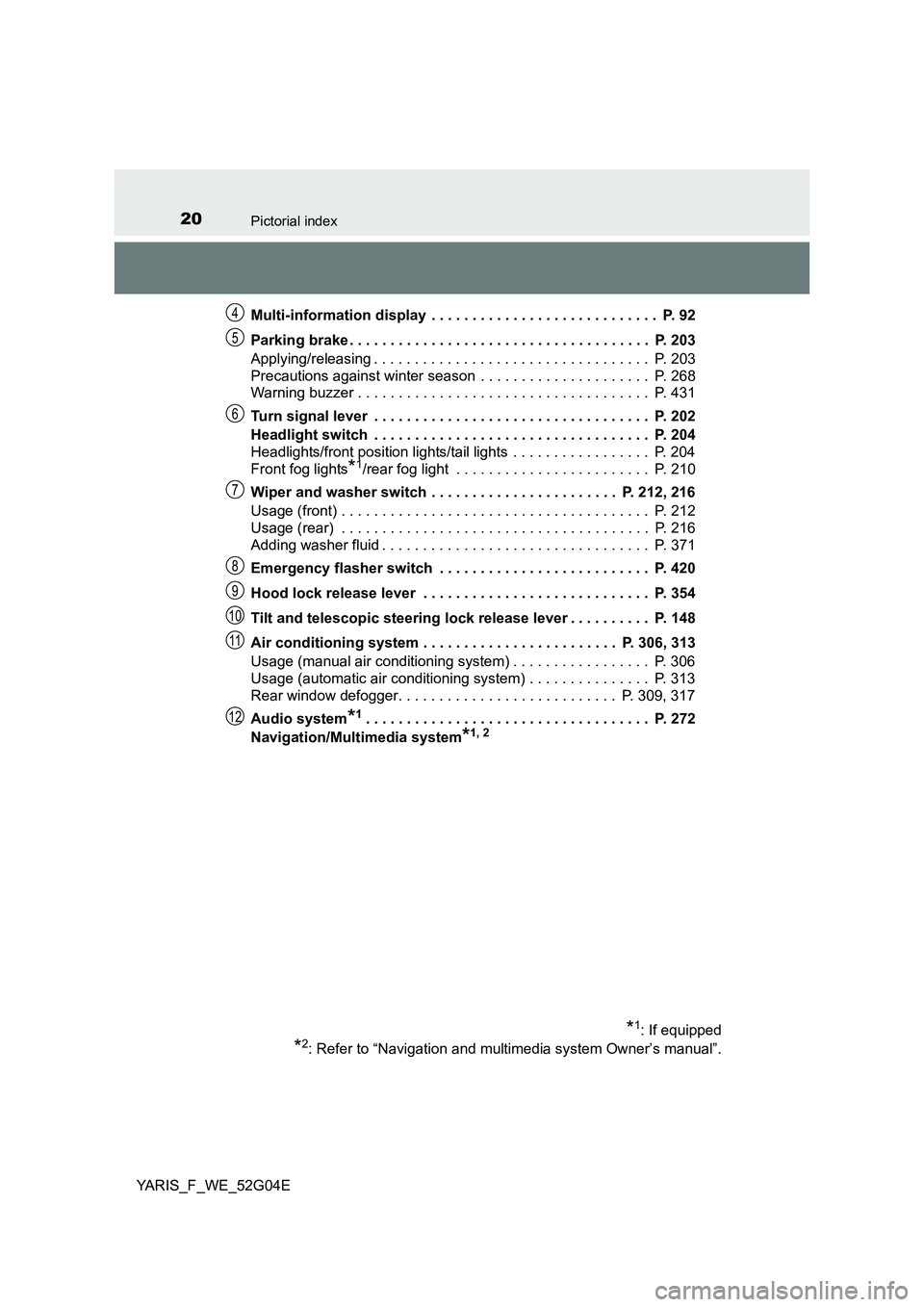
20Pictorial index
YARIS_F_WE_52G04E
Multi-information display . . . . . . . . . . . . . . . . . . . . . . . . . . . . P. 92
Parking brake . . . . . . . . . . . . . . . . . . . . . . . . . . . . . . . . . . . . . P. 203
Applying/releasing . . . . . . . . . . . . . . . . . . . . . . . . . . . . . . . . . . P. 203
Precautions against winter season . . . . . . . . . . . . . . . . . . . . . P. 268
Warning buzzer . . . . . . . . . . . . . . . . . . . . . . . . . . . . . . . . . . . . P. 431
Turn signal lever . . . . . . . . . . . . . . . . . . . . . . . . . . . . . . . . . . P. 202
Headlight switch . . . . . . . . . . . . . . . . . . . . . . . . . . . . . . . . . . P. 204
Headlights/front position lights/tail lights . . . . . . . . . . . . . . . . . P. 204
Front fog lights*1/rear fog light . . . . . . . . . . . . . . . . . . . . . . . . P. 210
Wiper and washer switch . . . . . . . . . . . . . . . . . . . . . . . P. 212, 216
Usage (front) . . . . . . . . . . . . . . . . . . . . . . . . . . . . . . . . . . . . . . P. 212
Usage (rear) . . . . . . . . . . . . . . . . . . . . . . . . . . . . . . . . . . . . . . P. 216
Adding washer fluid . . . . . . . . . . . . . . . . . . . . . . . . . . . . . . . . . P. 371
Emergency flasher switch . . . . . . . . . . . . . . . . . . . . . . . . . . P. 420
Hood lock release lever . . . . . . . . . . . . . . . . . . . . . . . . . . . . P. 354
Tilt and telescopic steering lock release lever . . . . . . . . . . P. 148
Air conditioning system . . . . . . . . . . . . . . . . . . . . . . . . P. 306, 313
Usage (manual air conditioning system) . . . . . . . . . . . . . . . . . P. 306
Usage (automatic air conditioning system) . . . . . . . . . . . . . . . P. 313
Rear window defogger. . . . . . . . . . . . . . . . . . . . . . . . . . . P. 309, 317
Audio system*1. . . . . . . . . . . . . . . . . . . . . . . . . . . . . . . . . . . P. 272
Navigation/Multimedia system*1, 2
*1: If equipped
*2: Refer to “Navigation and multimedia system Owner’s manual”.
4
5
6
7
8
9
10
11
12
Page 46 of 540
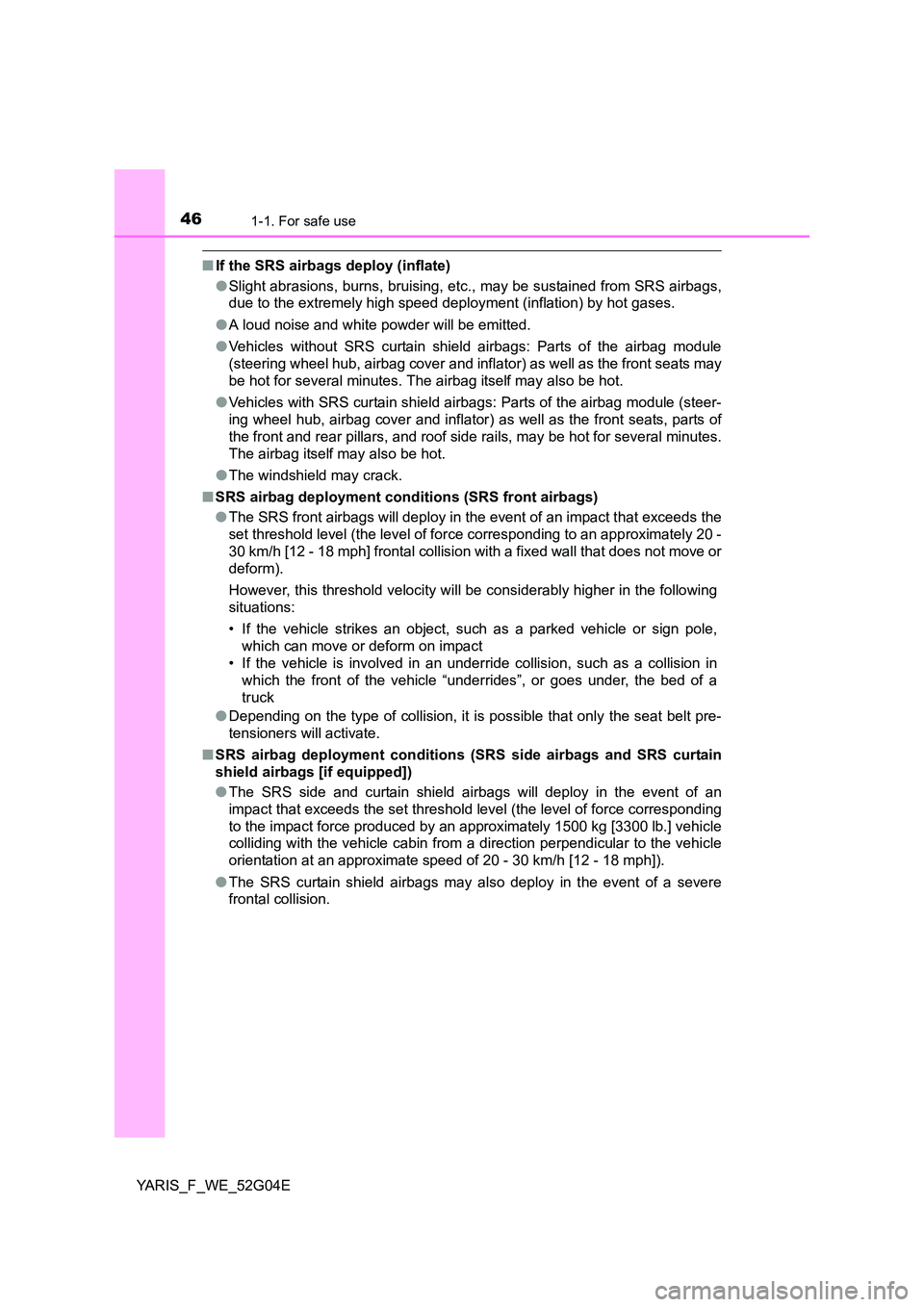
461-1. For safe use
YARIS_F_WE_52G04E
■If the SRS airbags deploy (inflate)
● Slight abrasions, burns, bruising, etc., may be sustained from SRS airbags,
due to the extremely high speed deployment (inflation) by hot gases.
● A loud noise and white powder will be emitted.
● Vehicles without SRS curtain shield airbags: Parts of the airbag module
(steering wheel hub, airbag cover and inflator) as well as the front seats may
be hot for several minutes. The airbag itself may also be hot.
● Vehicles with SRS curtain shield airbags: Parts of the airbag module (steer-
ing wheel hub, airbag cover and inflator) as well as the front seats, parts of
the front and rear pillars, and roof side rails, may be hot for several minutes.
The airbag itself may also be hot.
● The windshield may crack.
■ SRS airbag deployment conditions (SRS front airbags)
● The SRS front airbags will deploy in the event of an impact that exceeds the
set threshold level (the level of force corresponding to an approximately 20 -
30 km/h [12 - 18 mph] frontal collision with a fixed wall that does not move or
deform).
However, this threshold velocity will be considerably higher in the following
situations:
• If the vehicle strikes an object, such as a parked vehicle or sign pole,
which can move or deform on impact
• If the vehicle is involved in an underride collision, such as a collision in
which the front of the vehicle “underrides”, or goes under, the bed of a
truck
● Depending on the type of collision, it is possible that only the seat belt pre-
tensioners will activate.
■ SRS airbag deployment conditions (SRS side airbags and SRS curtain
shield airbags [if equipped])
● The SRS side and curtain shield airbags will deploy in the event of an
impact that exceeds the set threshold level (the level of force corresponding
to the impact force produced by an approximately 1500 kg [3300 lb.] vehicle
colliding with the vehicle cabin from a direction perpendicular to the vehicle
orientation at an approximate speed of 20 - 30 km/h [12 - 18 mph]).
● The SRS curtain shield airbags may also deploy in the event of a severe
frontal collision.
Page 47 of 540
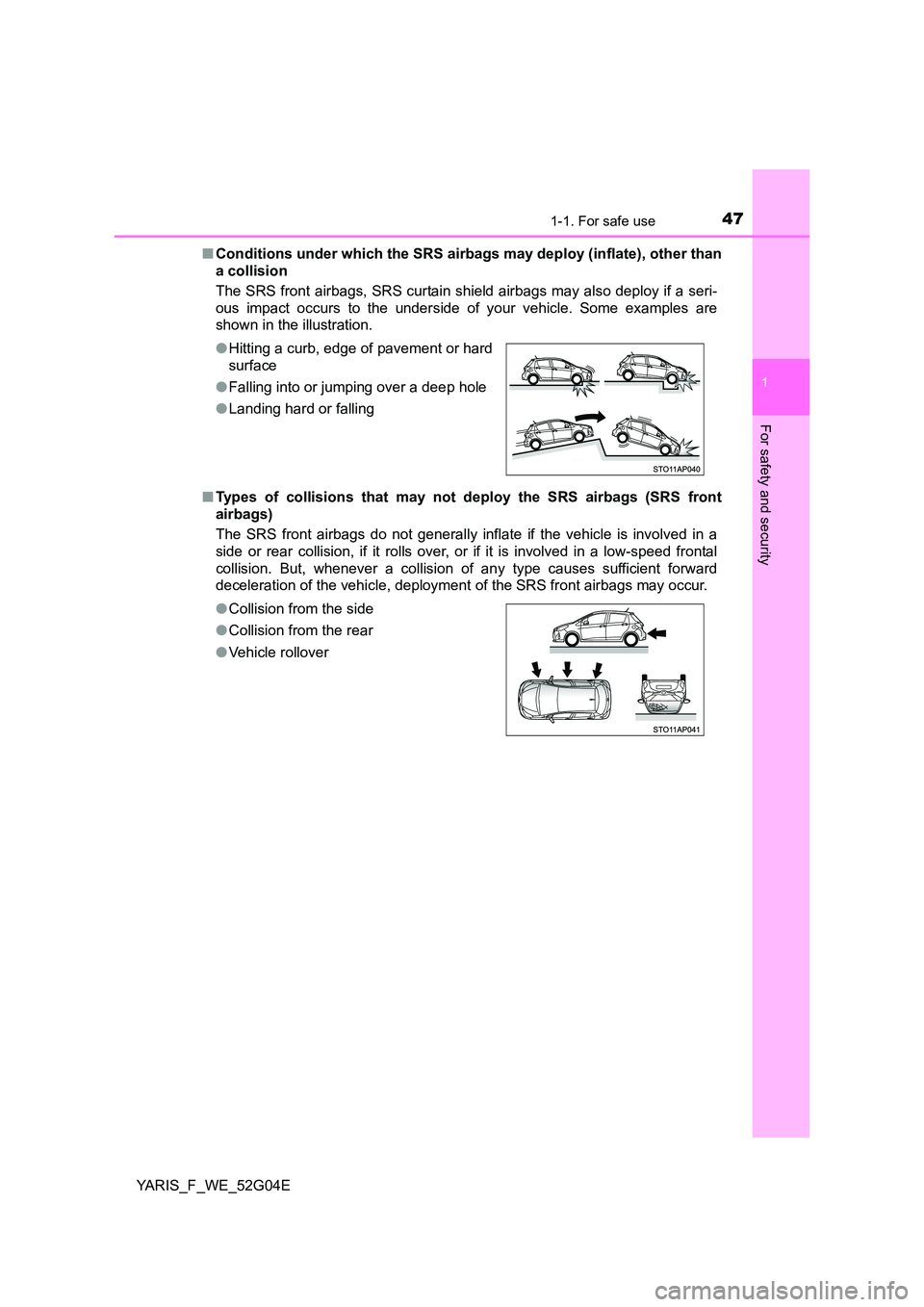
471-1. For safe use
1
For safety and security
YARIS_F_WE_52G04E
■ Conditions under which the SRS airbags may deploy (inflate), other than
a collision
The SRS front airbags, SRS curtain shield airbags may also deploy if a seri-
ous impact occurs to the underside of your vehicle. Some examples are
shown in the illustration.
■ Types of collisions that may not deploy the SRS airbags (SRS front
airbags)
The SRS front airbags do not generally infl ate if the vehicle is involved in a
side or rear collision, if it rolls over, or if it is involved in a low-speed frontal
collision. But, whenever a collision of any type causes sufficient forward
deceleration of the vehicle, deployment of the SRS front airbags may occur.
● Hitting a curb, edge of pavement or hard
surface
● Falling into or jumping over a deep hole
● Landing hard or falling
● Collision from the side
● Collision from the rear
● Vehicle rollover
Page 107 of 540
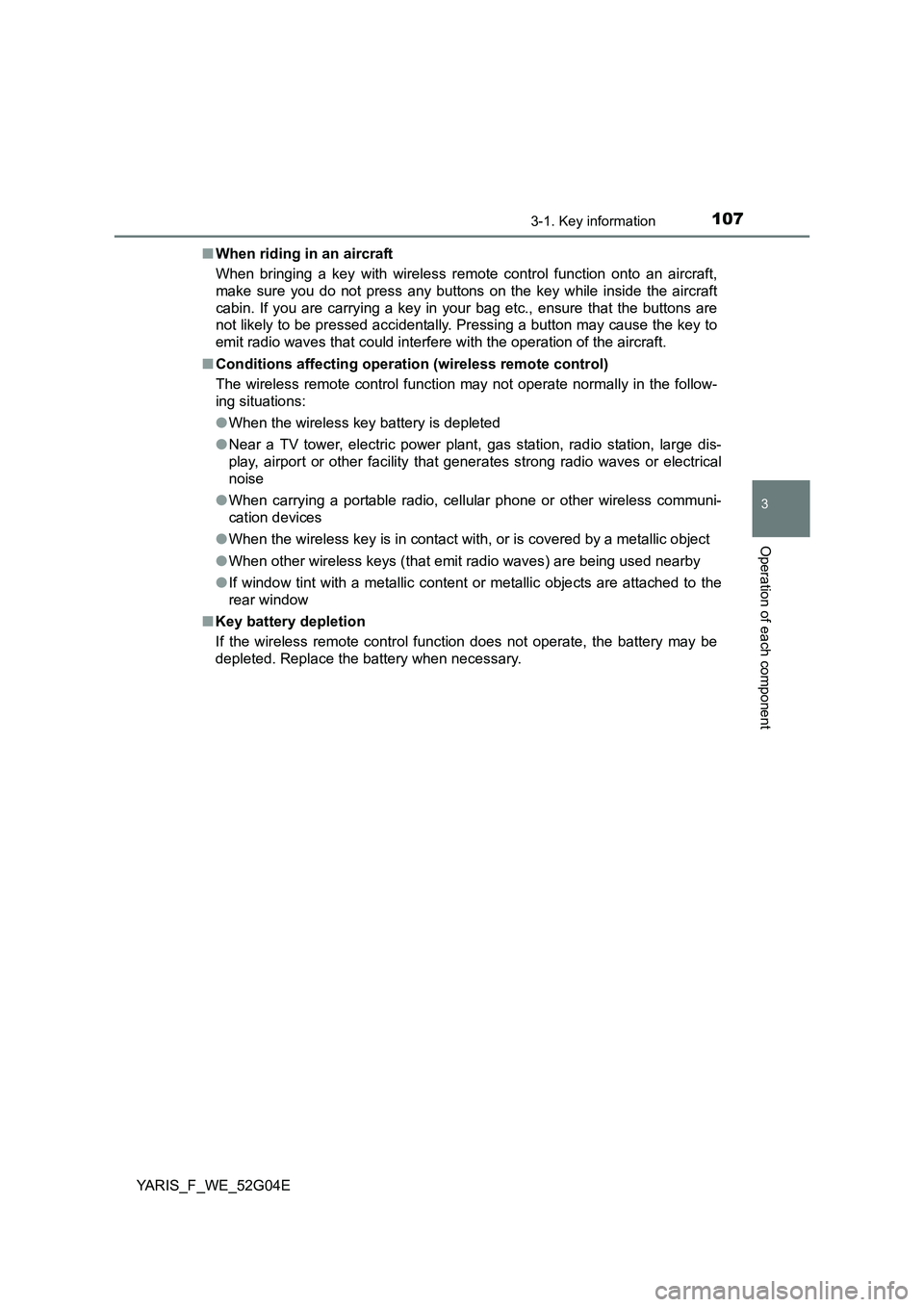
1073-1. Key information
3
Operation of each component
YARIS_F_WE_52G04E
■ When riding in an aircraft
When bringing a key with wireless remo te control function onto an aircraft,
make sure you do not press any buttons on the key while inside the aircraft
cabin. If you are carrying a key in your bag etc., ensure that the buttons are
not likely to be pressed accidentally. Pressing a button may cause the key to
emit radio waves that could interfere with the operation of the aircraft.
■ Conditions affecting operation (wireless remote control)
The wireless remote control function may not operate normally in the follow-
ing situations:
● When the wireless key battery is depleted
● Near a TV tower, electric power plant, gas station, radio station, large dis-
play, airport or other facility that generates strong radio waves or electrical
noise
● When carrying a portable radio, cellular phone or other wireless communi-
cation devices
● When the wireless key is in contact with, or is covered by a metallic object
● When other wireless keys (that emit radio waves) are being used nearby
● If window tint with a metallic content or metallic objects are attached to the
rear window
■ Key battery depletion
If the wireless remote control function does not operate, the battery may be
depleted. Replace the battery when necessary.
Page 132 of 540

1323-2. Opening, closing and locking the doors
YARIS_F_WE_52G04E
■ Conditions affecting operation
The smart entry & start system uses weak radio waves. In the following situa-
tions, the communication between the electronic key and the vehicle may be
affected, preventing the smart entry & start system, wireless remote control
and engine immobilizer system from operating properly.
(Ways of coping: P. 478)
● When the electronic key battery is depleted
● Near a TV tower, electric power plant, gas station, radio station, large dis-
play, airport or other facility that generates strong radio waves or electrical
noise
● When the electronic key is in contact with, or is covered by the following
metallic objects
• Cards to which aluminum foil is attached
• Cigarette boxes that have aluminum foil inside
• Metallic wallets or bags
• Coins
• Hand warmers made of metal
• Media such as CDs and DVDs
● When other wireless keys (that emit radio waves) are being used nearby
● When carrying the electronic key together with the following devices that
emit radio waves
• Portable radio, cellular phone, cordless phone or other wireless commu-
nication device
• Another vehicle’s electronic key or a wireless key that emits radio waves
• Personal computers or personal digital assistants (PDAs)
• Digital audio players
• Portable game systems
● If window tint with a metallic content or metallic objects are attached to the
rear window
● When the electronic key is placed near a battery charger or electronic
devices
Page 172 of 540

1724-1. Before driving
YARIS_F_WE_52G04E
NOTICE
■Avoiding damage to vehicle parts
● Do not turn the steering wheel fully in either direction and hold it there for
an extended period of time.
Doing so may damage the power steering motor.
● When driving over bumps in the road, drive as slowly as possible to avoid
damaging the wheels, underside of the vehicle, etc.
● Diesel engine only: Make sure to idle the engine immediately after high-
speed driving or hill climbing. Stop the engine only after the turbocharger
has cooled down.
Failure to do so may cause damage to the turbocharger.
■ If you get a flat tire while driving
A flat or damaged tire may cause the following situations. Hold the steering
wheel firmly and gradually depress the brake pedal to slow down the vehi-
cle.
● It may be difficult to control your vehicle.
● The vehicle will make abnormal sounds or vibrations.
● The vehicle will lean abnormally.
Information on what to do in case of a flat tire ( P. 445)
■ When encountering flooded roads
Do not drive on a road that has flooded after heavy rain, etc. Doing so may
cause the following serious damage to the vehicle:
● Engine stalling
● Short in electrical components
● Engine damage caused by water immersion
In the event that you drive on a flooded road and the vehicle is flooded, be
sure to have any authorized Toyota dealer or repairer or another duly quali-
fied and equipped professional check the following:
● Brake function
● Changes in quantity and quality of engine oil and transaxle fluid, etc.
● Lubricant condition for the bearings and suspension joints (where possi-
ble), and the function of all joints, bearings, etc.
Page 183 of 540
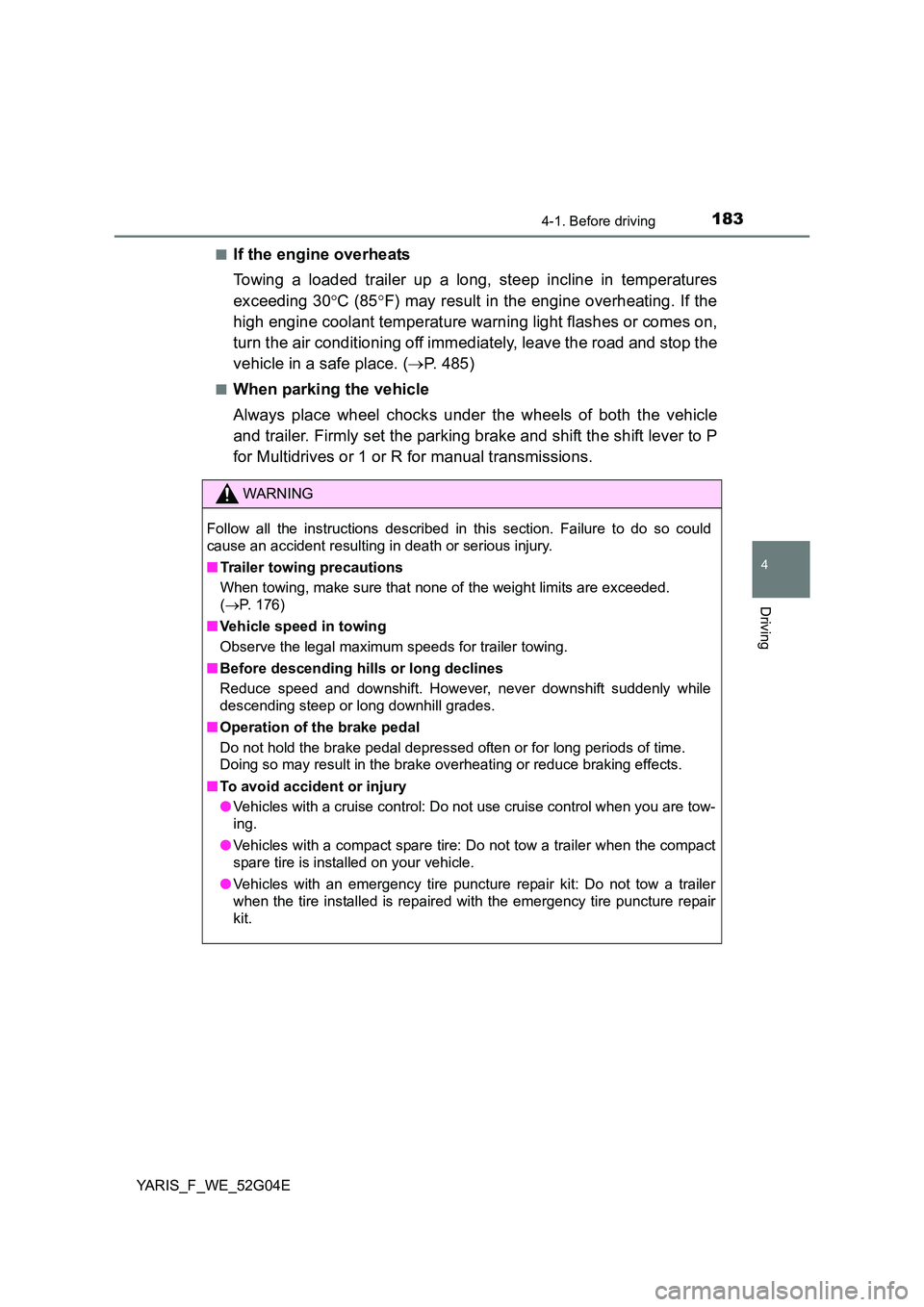
1834-1. Before driving
4
Driving
YARIS_F_WE_52G04E
■If the engine overheats
Towing a loaded trailer up a long, steep incline in temperatures
exceeding 30 C (85F) may result in the engine overheating. If the
high engine coolant temperature warning light flashes or comes on,
turn the air conditioning off immediately, leave the road and stop the
vehicle in a safe place. ( P. 485)
■When parking the vehicle
Always place wheel chocks under the wheels of both the vehicle
and trailer. Firmly set the parking brake and shift the shift lever to P
for Multidrives or 1 or R for manual transmissions.
WARNING
Follow all the instructions described in this section. Failure to do so could
cause an accident resulting in death or serious injury.
■ Trailer towing precautions
When towing, make sure that none of the weight limits are exceeded.
( P. 176)
■ Vehicle speed in towing
Observe the legal maximum speeds for trailer towing.
■ Before descending hills or long declines
Reduce speed and downshift. However, never downshift suddenly while
descending steep or long downhill grades.
■ Operation of the brake pedal
Do not hold the brake pedal depressed often or for long periods of time.
Doing so may result in the brake overheating or reduce braking effects.
■ To avoid accident or injury
● Vehicles with a cruise control: Do not use cruise control when you are tow-
ing.
● Vehicles with a compact spare tire: Do not tow a trailer when the compact
spare tire is installed on your vehicle.
● Vehicles with an emergency tire puncture repair kit: Do not tow a trailer
when the tire installed is repaired with the emergency tire puncture repair
kit.
Page 207 of 540

2074-3. Operating the lights and wipers
4
Driving
YARIS_F_WE_52G04E
Vehicle category N1*
*: To distinguish the vehicle category, ask any authorized Toyota dealer or
repairer, or another duly qualified and equipped professional.
■ Daytime running light system
To make your vehicle more visible to other drivers during daytime driving, the
daytime running lights turn on automatically whenever the engine is started
and the parking brake is released with the headlight switch off or in the
“AUTO” position. (Illuminate brighter than the front position lights.) Daytime
running lights are not designed for use at night.
■ Headlight control sensor (if equipped)
Loading conditionControl switch position
Driver only0
Driver + full luggage loading to the lug-
gage room4
The sensor may not function properly if an
object is placed on the sensor, or anything
that blocks the sensor is affixed to the
windshield.
Doing so interferes with the sensor
detecting the level of ambient light and
may cause the automatic headlight sys-
tem to malfunction.